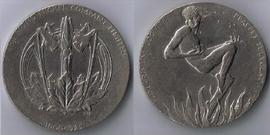The Canadian Bank of Commerce was first established on May 15, 1867 in Toronto, Ontario. Through amalgamations with regional banks, it grew to include branches across the country. With additional acquisitions in the 1920's, the bank became one of the strongest branch networks in Canada with well over 700 locations by 1929.
In 1936 the Canadian Bank of Commerce was the first bank in Canada to establish a personal loans department. At first, the bank would only issue loans, for a maximum of $1,000, in the Toronto and Hamilton areas. After the success of this pilot project, loans were extended to Canadians across the country.
During the second world war, the Canadian Bank of Commerce, along with other banks across Canada, assisted the government with the implementation of Victory Loans and War Ration coupons. The Victory Loan campaigns raised around $12 billion for the war effort, with almost three million Canadians buying war loan bonds. With the war ration coupons, banks became responsible for the accounting of food ration coupons in March, 1943 and gasoline ration coupons in April, 1944. The federal government first introduced ration coupons in April, 1942 for gasoline (until Aug 1945) and for certain food products in June, 1942 as a way of insuring equitable distribution of these supplies because of an acute shortage during the war. (Sugar - June 1942-1947, tea - 1942-Sept 1944, coffee - 1942-Sept 1944, butter - Dec 1942 -June 1947, meat - May 1943-March 1947, preserves - Dec 1943-1947, and in some areas evaporated milk - Dec 1943-1947.) After the initial year, the government decided banks in Canada were in a better position to handle the accounting aspect of the ration coupons and the banks agreed, provided they were able to limit the amount of paperwork involved. Dealers such as jobbers and brokers, wholesalers, creamery and cheese factories, importers of tea and coffee, retailers whose normal monthly gross sales in food exceeded $5,000, as well as businesses which served meals including the rationed goods, such as hotels, restaurants, and hospitals, were required to conduct ration bank accounts. With the ration bank accounts, these dealers and food server businesses would deposit and withdraw ration stamps in the same manner as financial accounts. Each ration product required a separate account for these businesses. When ration supplies were needed, a business would simply write a cheque in the amount of the ration stamps required from their specific product ration account. In turn, when customers purchased a rationed product, they would hand the business the required number of stamps and they would then deposit them into the specific ration accounts for their next purchase from their suppliers (both the businesses and the public were still required to pay cash for their rationed products along with the ration stamps.)
After the war, the Canadian Bank of Commerce increased their holdings to include branches in newly created suburbs and in 1954, along with the rest of the banks in Canada, began to offer mortgages for newly constructed homes. Prior to this time, all banks were barred from the mortgage business since 1871, leaving life insurance companies to offer the majority of mortgages to the public.
On June 1st 1961, the Canadian Imperial Bank of Commerce was formed through the merger of The Canadian Bank of Commerce and the Imperial Bank of Canada. The merger occurred due to both banks growth in the resource industry. The Imperial Bank of Canada was unable to keep up with the increasing needs of its resource industry clients and in an attempt to meet these needs and to ward off a possible buyout by a foreign bank, a new, larger bank was formed by the merger.
The Sudbury Branch of the Bank of Commerce first opened on June 22, 1929. Located on the corner of Elm and Elgin in the former Sterling Bank of Canada building, this bank became the eighth to locate to Sudbury (The Sterling Bank of Canada 1905-1924, opened January 30, 1909 in Sudbury. This bank merged with the Standard Bank of Canada in 1924 and the Standard Bank of Canada merged with the Canadian Bank of Commerce in 1928). The Town of Sudbury Building Permits record a H.R. Sheldon for Sterling Bank applying for a building permit on July 1, 1918 for 151 Elm Street. The building material included 80,000 bricks, 1,100 yards plastering, 1,000 cubic feet stone work, and 2,900 cubic feet concrete. This branch served as the main office in Sudbury until a larger branch was opened at the corner of Cedar and Lisgar Streets. As the Canadian Imperial Bank of Commerce, the Elm and Elgin branch merged with the Cedar Street branch on October 24, 1997, leaving the Elm and Elgin Street location vacant.
